Related Research Articles

The Jamestown settlement in the Colony of Virginia was the first permanent English settlement in the Americas. It was located on the northeast bank of the James River, about 2.5 mi (4 km) southwest of the center of modern Williamsburg. It was established by the Virginia Company of London as "James Fort" on May 4, 1607 O.S., and was considered permanent after a brief abandonment in 1610. It followed several failed attempts, including the Lost Colony of Roanoke, established in 1585 on Roanoke Island, later part of North Carolina. Jamestown served as the colonial capital from 1616 until 1699. Despite the dispatch of more settlers and supplies, more than 80 percent of the colonists died in 1609–1610, mostly from starvation and disease. In mid-1610, the survivors abandoned Jamestown, though they returned after meeting a resupply convoy in the James River.

Jamestown Settlement is a living history museum operated by the Commonwealth of Virginia, created in 1957 as Jamestown Festival Park for the 350th anniversary celebration. Today it includes a recreation of the original James Fort, a Powhatan Native American town, indoor and outdoor displays, and replicas of the original settlers' ships: the Susan Constant, Godspeed, and Discovery.

York County is a county in the eastern part of the Commonwealth of Virginia, located in the Tidewater. As of the 2020 census, the population was 70,045. The county seat is the unincorporated town of Yorktown.

Williamsburg is an independent city in Virginia, United States. As of the 2020 census, it had a population of 15,425. Located on the Virginia Peninsula, Williamsburg is in the northern part of the Hampton Roads metropolitan area. It is bordered by James City County on the west and south and York County on the east.

James City County is a county located in the Commonwealth of Virginia. As of the 2020 census, the population was 78,254. Although politically separate from the county, the county seat is the adjacent independent city of Williamsburg.

Hampton is an independent city in Virginia, United States. As of the 2020 census, the population was 137,148. It is the 7th-most populous city in Virginia and 204th-most populous city in the nation. Hampton is included in the Hampton Roads metropolitan area, the 37th-largest in the United States, with a total population of 1,799,674 in 2020. This area, known as "America's First Region", also includes the independent cities of Chesapeake, Virginia Beach, Newport News, Norfolk, Portsmouth, and Suffolk, as well as other smaller cities, counties, and towns of Hampton Roads.

Yorktown is a census-designated place (CDP) in York County, Virginia. It is the county seat of York County, one of the eight original shires formed in colonial Virginia in 1682. Yorktown's population was 195 as of the 2010 census, while York County's population was 66,134 in the 2011 census estimate.

Hampton Roads is the name of both a body of water in the United States that serves as a wide channel for the James, Nansemond, and Elizabeth rivers between Old Point Comfort and Sewell's Point near where the Chesapeake Bay flows into the Atlantic Ocean, and the surrounding metropolitan region located in the southeastern Virginia and northeastern North Carolina portions of the Tidewater Region.

The House of Burgesses was the elected representative element of the Virginia General Assembly, the legislative body of the Colony of Virginia.

The Virginia Peninsula is a peninsula in southeast Virginia, bounded by the York River, James River, Hampton Roads and Chesapeake Bay. It is sometimes known as the Lower Peninsula to distinguish it from two other peninsulas to the north, the Middle Peninsula and the Northern Neck.
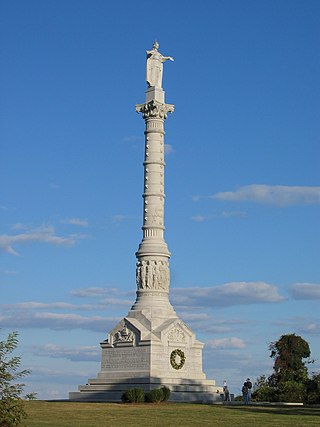
Colonial National Historical Park is a large national historical park located in the Hampton Roads region of Virginia operated by the National Park Service. It protects and interprets several sites relating to the Colony of Virginia and the history of the United States more broadly. These range from the site of the first English settlement at Jamestown, to the battlefields of Yorktown where the British Army was defeated in the American Revolutionary War. Over 3 million people visit the park each year.
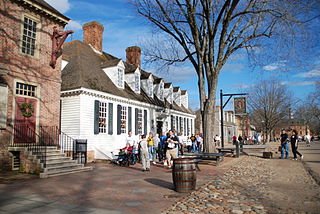
Colonial Williamsburg is a living-history museum and private foundation presenting a part of the historic district in the city of Williamsburg, Virginia. Its 301-acre (122 ha) historic area includes several hundred restored or recreated buildings from the 18th century, when the city was the capital of the Colony of Virginia; 17th-century, 19th-century, and Colonial Revival structures; and more recent reconstructions. The historic area includes three main thoroughfares and their connecting side streets that attempt to suggest the atmosphere and the circumstances of 18th-century Americans. Costumed employees work and dress as people did in the era, sometimes using colonial grammar and diction.
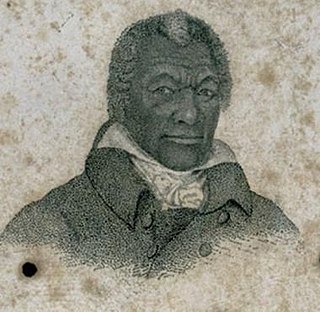
James Armistead Lafayette was an enslaved African American who served the Continental Army during the American Revolutionary War under the Marquis de Lafayette, and later received a legislative emancipation. As a double agent, he reported the activities of Benedict Arnold after he had defected to the British, and of Lord Charles Cornwallis during the run-up to the siege of Yorktown. He fed the British false information while disclosing very accurate and detailed accounts to the Americans.
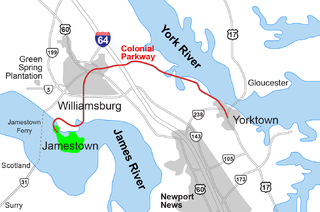
The Historic Triangle includes three historic colonial communities located on the Virginia Peninsula of the United States and is bounded by the York River on the north and the James River on the south. The points that form the triangle are Jamestown, Colonial Williamsburg, and Yorktown. They feature many restored attractions and are linked by the Colonial Parkway in James City and York counties, and the City of Williamsburg.

Jamestown 2007 is the name of the organization which planned the events commemorating the 400th anniversary (quadricentennial) of the founding of Jamestown, Virginia in 1607, the first permanent English-speaking settlement in what is now the United States of America. America's 400th Anniversary was an 18-month-long commemoration including 10 Signature Events, hundreds of community programs and dozens of partner and programs and events. Activities took place throughout Virginia, in major cities along the East Coast, and in the United Kingdom.
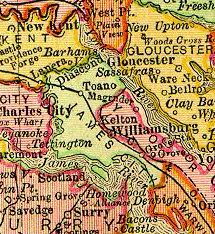
Grove is an unincorporated community in the southeastern portion of James City County in the Virginia Peninsula subregion of Virginia in the United States. It is located in the center of the Historic Triangle of Colonial Virginia, communities linked by the Colonial Parkway. This area is one of the busiest tourist destinations in the world.
Parke Shepherd Rouse Jr. was an American journalist, writer and historian in Tidewater Virginia.

The history of Hampton Roads dates to 1607, when Jamestown was founded. Two wars have taken place in addition to many other historical events.

The President's House is the residence of the President of the College of William and Mary in Virginia in Williamsburg, Virginia. Constructed in 1732, the building still serves its original purpose and is among the oldest buildings in Virginia. Since its construction only one of the college's presidents, Robert Saunders Jr., has not moved into the building, which is let for free to the president. The President's House is William & Mary's third-oldest building and the oldest official college presidential residence in the United States.
Elizabeth Jaquelin Ambler Brent Carrington also known as Betsy Ambler Carrington founded the Female Humane Association in Richmond, Virginia. It is now known as the Memorial Foundation for Children. Believed to be the first of its kind in Virginia, the organization provided safety and shelter to destitute girls and kept they from a life of poverty and the possibility of becoming prostitutes to survive.
References
- 1 2 Davenport, Andrew M. (May 2, 2019). "A New Civil War Museum Speaks Truths in the Former Capital of the Confederacy". smithsonianmag.com. Retrieved July 24, 2020.
- ↑ Fernandez, Mariana (May 20, 2019). "The American Civil War Museum's CEO on the Myths That Persist About Our National Conflict". observer.com. Retrieved July 24, 2020.
- ↑ Lohmann, Bill (January 17, 2020). "In Richmond, Christy Coleman helped reframe the narrative of the Civil War; Now, as she heads to Williamsburg, she looks back at her career in history". Richmond Times-Dispatch. Archived from the original on July 25, 2020. Retrieved July 24, 2020.
- 1 2 3 Kneebone, John (June 10, 2019). "A Conversation with Christy Coleman: Prof. Kneebone Interviews the CEO of the American Civil War Museum about Her Road to Public History". rampages.us. Retrieved July 25, 2020.
- 1 2 McCluskey, Amy (February 10, 2020). "Christy Coleman, Jamestown-Yorktown Foundation executive director". pilotonline.com. Retrieved July 24, 2020.
- 1 2 3 Duster, Chandelis R. (July 12, 2017). "Meet The Black Woman Reclaiming the Narrative of the Civil War". nbcnews.com. Retrieved July 24, 2020.
- ↑ "'Slave auction' divides crowd in Williamsburg". Baltimore Sun. October 11, 1994. Retrieved July 24, 2020.
- ↑ "Turning back time". Metro Times. December 1, 2004. Retrieved July 25, 2020.
- ↑ Colby, Joy Hakansan (December 3, 2005). "Museum president resigns to become full-time mother". Detroit Free Press. Retrieved July 25, 2020– via Newspapers.com.
- ↑ S. Schneider, Gregory (April 15, 2018). "An African American leader brings a provocative take to expanded Civil War museum". The Washington Post . Archived from the original on April 16, 2018. Retrieved July 25, 2020.
- ↑ Curran, Colleen (August 12, 2018). "Richmond's Christy Coleman named by Time as one of '31 People Changing the South'". Richmond Times-Dispatch . Retrieved July 25, 2020.
- ↑ Doiron, Alexa (December 17, 2019). "Jamestown-Yorktown Foundation has a new executive director". wydaily.com. Retrieved July 25, 2020.
- ↑ Robers Jr., Steve (April 20, 2020). "Three months in, Christy Coleman's vision for Jamestown-Yorktown Foundation looks beyond pain of pandemic: 'Everything's on the table'". The Virginia Gazette. Retrieved July 24, 2020.
- ↑ Eshleman, Tina (October 20, 2017). "Flip to the Back: Christy Coleman". richmondmagazine.com. Retrieved July 25, 2020.